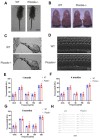Piccolo is essential for the maintenance of mouse retina but not cochlear hair cell function
- PMID: 33882456
- PMCID: PMC8109093
- DOI: 10.18632/aging.202861
Piccolo is essential for the maintenance of mouse retina but not cochlear hair cell function
Abstract
Piccolo is a presynaptic protein with high conservation among different species, and the expression of Piccolo is extensive in vertebrates. Recently, a small fragment of Piccolo (Piccolino), arising due to the incomplete splicing of intron 5/6, was found to be present in the synapses of retinas and cochleae. However, the comprehensive function of Piccolo in the retina and cochlea remains unclear. In this study, we generated Piccolo knockout mice using CRISPR-Cas9 technology to explore the function of Piccolo. Unexpectedly, whereas no abnormalities were found in the cochlear hair cells of the mutant mice, significant differences were found in the retinas, in which two layers (the outer nuclear layer and the outer plexiform layer) were absent. Additionally, the amplitudes of electroretinograms were significantly reduced and pigmentation was observed in the fundoscopy of the mutant mouse retinas. The expression levels of Bassoon, a homolog of Piccolo, as well as synapse-associated proteins CtBP1, CtBP2, Kif3A, and Rim1 were down-regulated. The numbers of ribbon synapses in the retinas of the mutant mice were also reduced. Altogether, the phenotype of Piccolo-/- mice resembled the symptoms of retinitis pigmentosa (RP) in humans, suggesting Piccolo might be a candidate gene of RP and indicates Piccolo knockout mice are a good model for elucidating the molecular mechanisms of RP.
Keywords: CRISPR/Cas9; cochlea; mouse; piccolo; retina.
Conflict of interest statement
Figures








References
Publication types
MeSH terms
Substances
LinkOut - more resources
Full Text Sources
Other Literature Sources
Molecular Biology Databases
Research Materials

